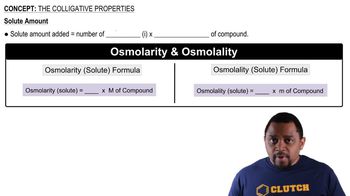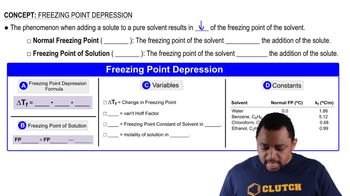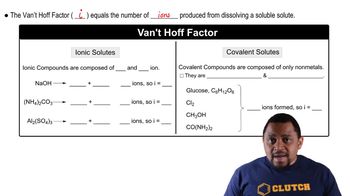Here are the essential concepts you must grasp in order to answer the question correctly.
Colligative Properties
Colligative properties are physical properties of solutions that depend on the number of solute particles in a given amount of solvent, rather than the identity of the solute. These properties include boiling point elevation, freezing point depression, vapor pressure lowering, and osmotic pressure. Understanding colligative properties is essential for calculating changes in freezing point when a solute is added to a solvent.
Recommended video:
Freezing Point Depression
Freezing point depression is a colligative property that describes the decrease in the freezing point of a solvent when a solute is added. The extent of freezing point depression can be calculated using the formula ΔTf = i * Kf * m, where ΔTf is the change in freezing point, i is the van't Hoff factor, Kf is the freezing point depression constant of the solvent, and m is the molality of the solution. This concept is crucial for determining the van't Hoff factor in the given problem.
Recommended video:
Freezing Point Depression
van't Hoff Factor (i)
The van't Hoff factor (i) is a dimensionless number that represents the number of particles into which a solute dissociates in solution. For non-electrolytes, i is typically 1, while for electrolytes, it corresponds to the number of ions produced. In the case of HCl, which dissociates into H⁺ and Cl⁻ ions, the van't Hoff factor is 2. This factor is vital for accurately calculating colligative properties like freezing point depression.
Recommended video:
 Verified step by step guidance
Verified step by step guidance


